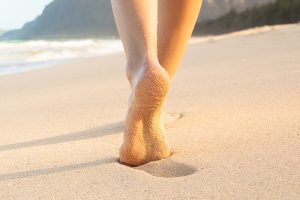

With the growing popularity of barefoot running shoes and our love as a nation for hitting our beautiful beaches when the sun is out, there’s one question that we often get asked as podiatrists: is barefoot walking bad for our feet?
While some people can spend their lives in bare feet without any pain, if you are one of the many people who do experience pain or discomfort when walking barefoot, you may be vulnerable to one of a number of common foot conditions which if left undiagnosed and untreated, can lead to discomfort and ongoing complications.
What happens if you walk barefoot all the time?
When we walk with good, supportive footwear, our shoes act as an extension of our feet and become the ground we walk on. Instead of coming in contact with the often hard, flat ground surface, we come in contact with a supportive, stabilising surface that absorbs a lot of forces from the ground for us, instead of our feet having to take them on. This helps prevent our muscles, tendons and joints from being overused, can limit excessive and potentially harmful movement, reduces the pressure and stress our feet and legs are exposed to, and overall helps us walk more comfortably for longer and stay pain and injury-free.
When we walk in bare feet and are completely vulnerable to whatever ground surface we’re walking on – whether that’s the sand at the beach, the pavement, a rocky terrain or the grassy field – it is the ground that influences how our feet move and the forces they are exposed to instead. While good shoes are designed to help our feet, the ground outside is not. Therefore, we have a much higher likelihood of experiencing pain, injuries and discomfort when we walk with bare feet.
Common pains that arise from prolonged barefoot walking include:
Plantar Fasciitis
The plantar fascia is a strong tissue that runs from our heel, across our arch and to the toes. When our feet flatten completely without any arch support, the fascia is maximally strained. When this happens step after step, it may become vulnerable to microtears from being overstretched and strained. Good shoes (especially with orthotics) ensure the fascia remains well supported with every step to prevent this injury.
Heel & Achilles Pain
When we take a step, the first part of the foot to strike the ground is our heel. When we do this step after step on hard and unforgiving surfaces, and the forces from the hard ground are transferred through the back of our heels and up the leg, we may be more vulnerable of developing heel & Achilles pain.
Metatarsalgia
Metatarsalgia is the general term for pain at the midfoot. Given the large number of bones, joints, ligaments and tendons in this area of the foot, exposing the midfoot to all the ground reaction forces and the hard surface of the ground with every step, walking without any additional cushioning or support from footwear can lead to midfoot and forefoot pain, injury and overuse.
Stone Bruising & Fat Pad Injury
We’ve all had the painful experience of accidentally treading barefoot on a rock or small object. This often leads to deep bruising and inflammation on the fat pad of the heel or the ball of the foot.
Do you have diabetes?
If you have been diagnosed with diabetes, you should never walk barefoot – especially if you have impaired circulation or neuropathy that leaves you less able to detect injuries to the skin of your feet, as well as less likely to heal these injuries or fight infection. This means that minor problems that usually heal quickly can easily become infected and develop ulcers – and unnoticed problems can escalate quickly.
According to Diabetese Australia, there are 12 diabetes-related amputations performed at Australian hospitals every day. Although walking with bare feet is tempting, try to avoid doing so when going outside – and avoid it entirely if you are diabetic. Even slipping on a pair of thongs beside the pool or to head to the beach goes a long way to protecting the soles of your feet from burns, cuts and diseases.
Is it bad to wear shoes all the time?
While it is best to always wear shoes while walking outside, walking barefoot around your home can allow your feet to rest. It is not bad to wear shoes most of the time so long as your shoes provide suitable support and are designed to promote your foot health.


